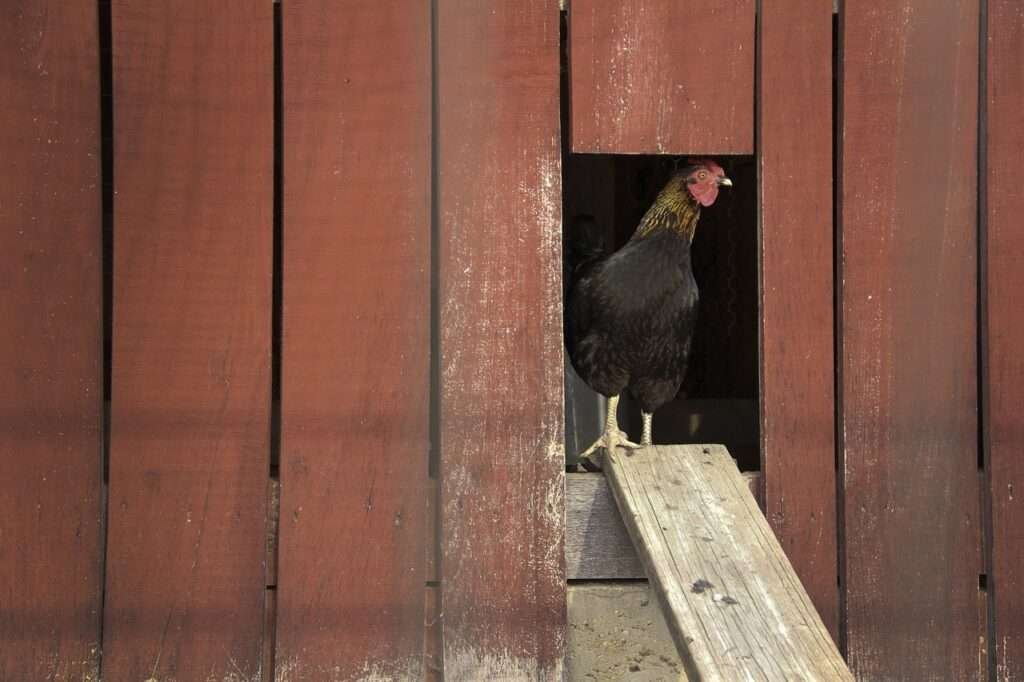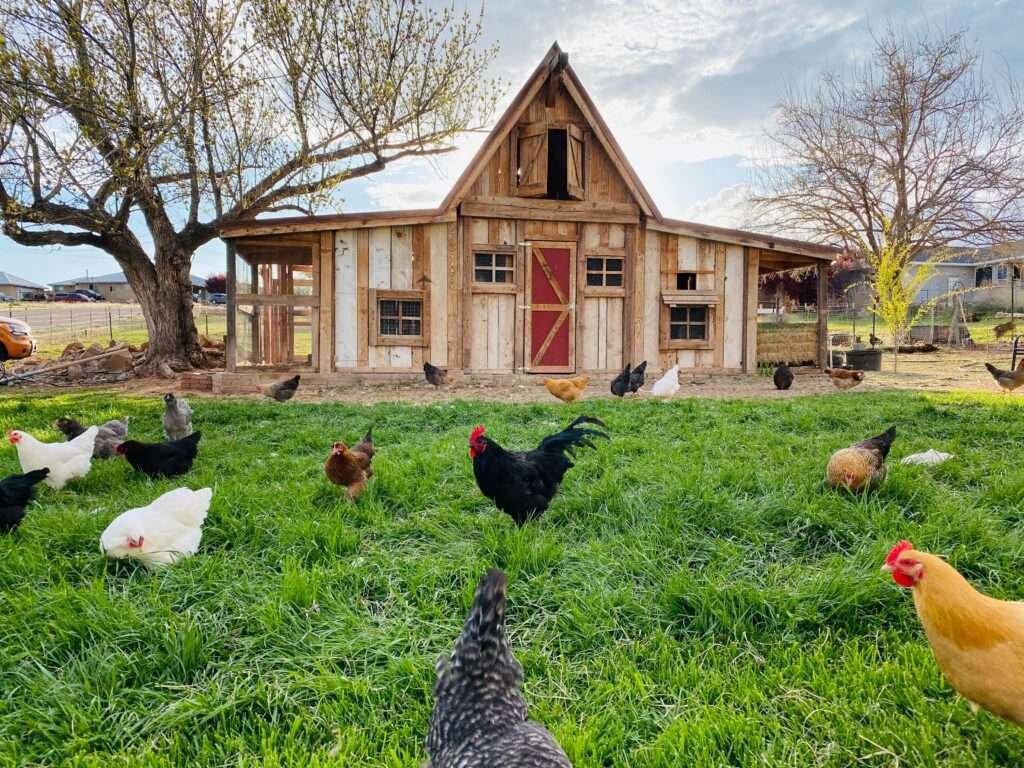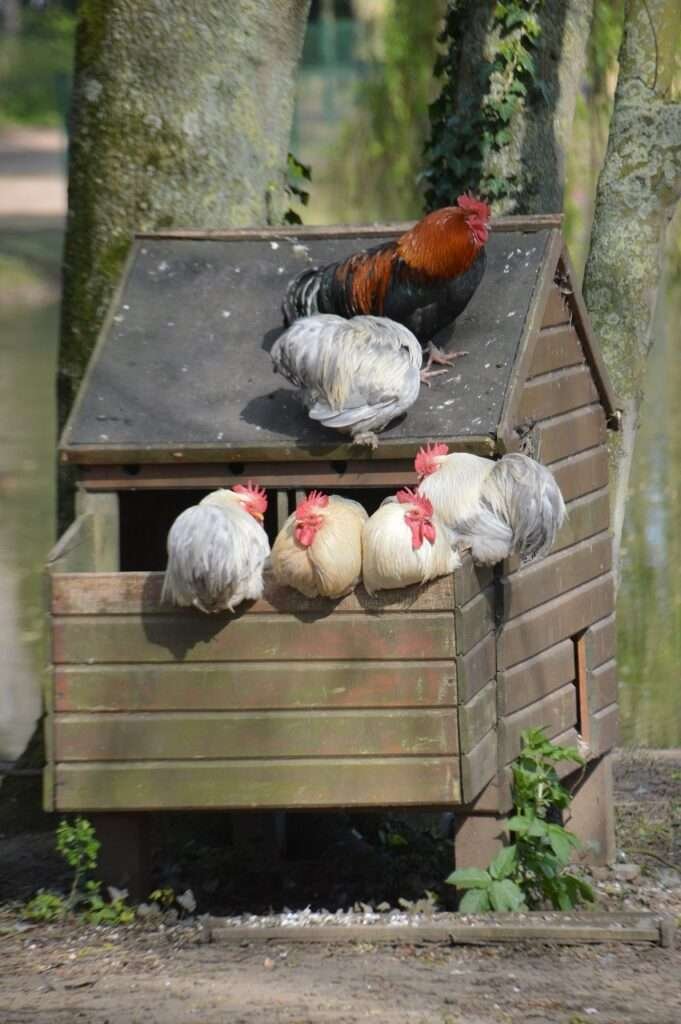Choosing the right scheme for your chicken coop colors is more than just an aesthetic decision; it can significantly impact the well-being and stress levels of your feathered friends. As backyard chicken enthusiasts, we understand that a happy and relaxed flock leads to healthier egg production and an overall more enjoyable chicken-keeping experience. In this guide, we’ll delve into the art and science of selecting the best chicken coop colors, both indoors and outdoors, aiming to strike a balance between visual appeal and stress reduction.

Choosing the Right Chicken Coop Colors
Before we dive into specific color choices, let’s explore the general considerations when deciding on the color scheme for your chicken coop. The climate, location, and size of your coop all play crucial roles in determining the most suitable colors. While aesthetics are essential, functionality should also be a key factor in your decision-making process.
Consider the local climate when selecting colors for your coop’s exterior. Lighter chicken coop colors can help reflect sunlight and prevent overheating in warmer regions, while darker colors may be more suitable for colder climates, helping to absorb and retain heat. Additionally, the size of your coop and its proximity to other structures can influence the overall impact of colors on the environment.
Now, let’s break down our discussion into indoor and outdoor coop colors, exploring the nuances and benefits associated with each.

Indoor Coop Colors
The colors you choose for the interior of your chicken coop can have a profound impact on the stress levels of your flock. Chickens, like many animals, respond to colors in various ways, and understanding the psychology behind these reactions can guide your decision-making.
When selecting indoor coop colors, prioritize calming and neutral tones. Shades of blue and green, reminiscent of the sky and grass, can create a soothing environment. These colors are known to have a relaxing effect on both animals and humans. Additionally, lighter colors contribute to a brighter and more visually appealing space, enhancing visibility and cleanliness.
As you paint the interior of your coop, consider the practical aspects of maintenance. Lighter chicken coop colors can make it easier to spot any signs of dirt or pests, facilitating regular cleaning and health checks. Striking the right balance between calming hues and practical considerations sets the foundation for a stress-free indoor environment for your chickens.

Outdoor Coop Colors
As we shift our focus to the exterior of the chicken coop, the considerations broaden to encompass not only aesthetics but also functionality and the surrounding environment. Outdoor coop colors play a vital role in regulating temperature, ensuring the well-being of your chickens in various weather conditions.
When selecting colors for the exterior, keep in mind the climate of your location. In warmer regions, where the sun can beat down intensely, choosing lighter colors for your coop can be advantageous. Lighter shades, such as whites and pastels, reflect sunlight, helping to maintain a cooler interior temperature. This is particularly crucial during scorching summers when overheating can pose a threat to your flock.
Conversely, if you’re in a colder climate, darker colors can absorb and retain heat, providing a bit of extra warmth for your chickens. Earthy tones like browns and greens can blend well with natural surroundings while serving a practical purpose in temperature regulation.
Beyond temperature considerations, the color of your coop’s exterior also contributes to its overall appearance in your backyard. Many chicken keepers take pride in creating visually appealing coops that complement the surrounding landscape. Vibrant colors can add a touch of personality to your coop, turning it into a focal point of your backyard while still maintaining a balance with the natural environment.

Top 5 Chicken Coop Colors for Low Stress Chickens
Now, let’s delve into a curated list of the top five colors known to reduce stress in chickens. These colors have been chosen based on their calming effects and positive impact on the overall well-being of poultry.
- Sky Blue:
- Reminiscent of a clear sky, sky blue has a calming effect on chickens. It promotes a sense of tranquility and openness, creating a stress-free environment.
- Leaf Green:
- Reflecting the color of fresh leaves, green is associated with nature and growth. Chickens often respond positively to this color, fostering a connection with the outdoors.
- Soft Lavender:
- Lavender is known for its relaxing properties. Using a soft lavender tone in your coop can contribute to a peaceful atmosphere, especially during the evening.
- Warm Taupe:
- A neutral and earthy color, warm taupe provides a cozy and grounding effect. It blends well with natural surroundings while promoting a sense of security for your chickens.
- Buttercream Yellow:
- Yellow evokes feelings of warmth and positivity. A buttercream yellow can bring brightness to the coop, enhancing visibility and creating a cheerful atmosphere.
Experimenting with Color Combinations for a Harmonious Coop
Now that we’ve explored the impact of indoor and outdoor coop colors, it’s time to discuss the art of experimenting with color combinations. Creating a harmonious and visually appealing chicken coop involves striking the right balance between various hues to enhance both the aesthetics and functionality of the space.
Consider the following tips when experimenting with color combinations:
- Contrasting Elements:
- Introduce contrasting elements to create visual interest. For example, pairing a calming blue with a warm taupe can add depth to the coop’s overall appearance.
- Accent Colors:
- Incorporate accent colors strategically. These can be vibrant tones used sparingly to highlight specific features, such as window frames or trim.
- Blend with Natural Surroundings:
- Choose colors that complement the natural surroundings of your backyard. Harmonizing with the environment creates a coop that feels integrated into its setting.
- Consider Chicken Breed Colors:
- Take into account the colors of your chicken breeds. A coop that complements the feathers of your flock can create a cohesive and visually pleasing scene.
- Experiment with Patterns:
- If you’re feeling adventurous, consider incorporating patterns or textures into your coop design. Patterns can add character and uniqueness to the space.
Remember that experimenting with color combinations is a creative process, and there’s no one-size-fits-all solution. Don’t be afraid to express your personal style and preferences through the colors you choose for your coop. Your chickens, too, will appreciate a coop that reflects a sense of care and attention to detail.

The Best Chicken Coop Color For You
The colors you choose for your chicken coop play a significant role in the well-being of your flock. By prioritizing calming and neutral tones, both indoors and outdoors, you can create a stress-free environment that promotes the health and happiness of your chickens.
Experimenting with color combinations adds a personal touch to your coop, allowing you to create a space that not only serves its practical functions but also enhances the overall aesthetic appeal. Whether you opt for the calming hues of sky blue or the grounding effect of warm taupe, the key is to strike a balance that suits both your taste and the well-being of your feathered friends.
As you embark on the journey of painting your chicken coop, consider it an opportunity to connect with your backyard space and create a haven for your chickens. The right colors can transform your coop into a delightful retreat, fostering a sense of peace and joy for both you and your flock.

Chicken Coop Colors FAQ: Best Scheme For Low Stress Chickens
- Q: Do chicken coop colors really impact the stress levels of chickens?
- A: Yes, studies suggest that certain colors can have a calming effect on chickens. Choosing the right colors for your coop can contribute to a low-stress environment for your feathered friends.
- Q: Are there specific colors that chickens find stressful?
- A: While individual preferences may vary, bright and intense colors can sometimes be overwhelming for chickens. It’s generally recommended to opt for calming and neutral tones.
- Q: How can I determine the best color scheme for my specific climate?
- A: Consider the climate of your location. Lighter colors reflect sunlight and are suitable for warmer regions, while darker colors can provide additional warmth in colder climates.
- Q: Are there any colors that deter pests or predators?
- A: While coop colors may not directly deter pests, a well-maintained and clean coop is essential for pest prevention. Lighter colors can make it easier to spot any signs of infestation.
- Q: Can I use patterns or multiple colors in my coop design?
- A: Experimenting with patterns or multiple colors can add character to your coop. However, it’s essential to ensure that the overall design remains visually pleasing and not too overwhelming.
- Q: Will the color of my coop affect egg production?
- A: There’s no direct evidence that coop color significantly impacts egg production. However, a stress-free environment created by suitable colors may indirectly contribute to healthier and more consistent egg-laying.
- Q: Can I repaint my coop if I’m not satisfied with the color scheme?
- A: Absolutely! Repainting your coop is a straightforward process. If you find that the current color scheme isn’t achieving the desired effect, feel free to experiment with new colors until you achieve the perfect combination.
Choosing the right colors for your chicken coop is a creative and rewarding process. These FAQs provide insights into common concerns, but remember that every coop is unique, and personal preferences play a significant role in creating a space that both you and your chickens will enjoy.






